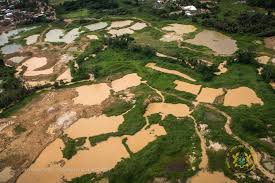Ghana’s water bodies are polluted, cocoa farms are destroyed, and dangerous metals like mercury and arsenic remain in the soil.
Communities close to galamsey sites now face unsafe water, poor farmlands and health risks.
The big question is: How do we reclaim these lands and even restore them in the future?
Science and practice give us some answers.
If we learn from how abandoned mines are reclaimed and apply it carefully to Ghana’s situation, we can bring life back to galamsey lands.
Reclamation vs restoration: Difference?
When talking about healing damaged lands, two words often come up: reclamation and restoration.
They sound similar, but scientists use them differently.
• Reclamation focuses on making damaged land useful again.
The main aim is stability and productivity.
For example, filling galamsey pits, adding topsoil, planting grasses or trees so that erosion stops and the land can support forestry.
Reclaimed land may not look like the original forest, but it becomes productive.
• Restoration goes further. It tries to bring back the land to its original state before mining.
This means returning the same type of forest, biodiversity, soil quality and ecosystem services that existed before.
Restoration is often harder, slower and more expensive, but it gives the land back its full ecological value.
Why reclamation matters?
If Galamsey open pits are left as they are, poisons will continue to spread into our rivers and food.
But with proper reclamation, these same lands can support forests, farms and safe communities again.
It is not just about planting trees.
It is about healing the soil and removing toxins.
With commitment, Ghana can turn today’s scars into tomorrow’s green landscapes.
Ghana’s mining laws show that legal mining companies are required to reclaim mined lands.
For instance, L.I. 1652 demands a reclamation bond, while L.I. 2173 and L.I. 2182 require closure plans before mines shut down.
In forest reserves, L.I. 2462 goes further, forcing legal mining companies to submit decommissioning and end-use plans.
But here is the problem: Galamsey is illegal mining, so the operators do not follow these laws.
They dig and leave behind open pits, poisoned soils and polluted rivers.
In the case of galamsey, reclamation is the realistic first step.
Over time, with careful management, parts of the land can move closer to restoration.
Science, reclamation
Reclamation follows a clear process:
• Reshape the land: Fill the pits, smooth the slopes, and build drains to reduce erosion.
• Improve the soil: Add compost, biochar or lime to reduce acidity and help plants grow.
• Plant carefully: Choose plants that not only provide cover but also absorb harmful metals from the soil (a process called phytoremediation).
Full recovery of abandoned galamsey pits may take decades; however, noticeable improvements in soil quality and vegetation will usually appear over the short to medium term when the land is properly reclaimed.
Ghana’s case: More than just tree planting
Reclamation efforts in Ghana often focus only on tree planting.
But this is not enough because galamsey soils contain toxic metals such as arsenic, cadmium, mercury and chromium.
A 2024 study found that abandoned mining sites had over 6,000 naturally growing seedlings of 133 species (Asare et al., 2024).
Some of these plants were able to absorb metals such as cadmium and lead.
This means Ghana must go beyond planting timber trees.
We must combine trees with phytoremediator plants that can clean up the soil.
Timber trees, phytoremediation
Timber species such as teak, mahogany, emire and ofram are valuable for restoring forests and providing economic benefits. However, they are not proven to remove heavy metals quickly.
Their role is more about stabilising the soil, giving shade and supporting biodiversity.
For cleaning toxins, fast-growing grasses and shrubs are better.
For example, Chromolaena odorata (locally known as Akyeampong) and Mimosa pudica (sensitive plant or touch me not) possess the potential to absorb heavy metals such as cadmium and lead.
Adding biochar from cocoa pods or rice husks will reduce mercury and arsenic in the soil while improving fertility.
The better strategy for reclamation of abandoned mine pits could be planting phytoremediator plants together with timber trees and adding biochar.
The smaller plants and the biochar clean the soil while the timber trees grow for the long term.
Roadmap
To reclaim galamsey lands, Ghana needs a science-based plan:
• Test the soil and water to know the level of contamination.
• Start pilot projects by trying different plant combinations in smaller plots first.
• Plant in phases: Use fast-growing plants for cleanup, then add timber trees for long-term use.
• Involve communities by training the youth and farmers to raise seedlings and manage sites.
• Monitor and share results: Report reductions in metals such as mercury, arsenic and lead so that progress is visible.
The writers are workers of GEA SHEQ Africa Consult Ltd, Tema
and an Environmental Scientist & Researcher respectivily



